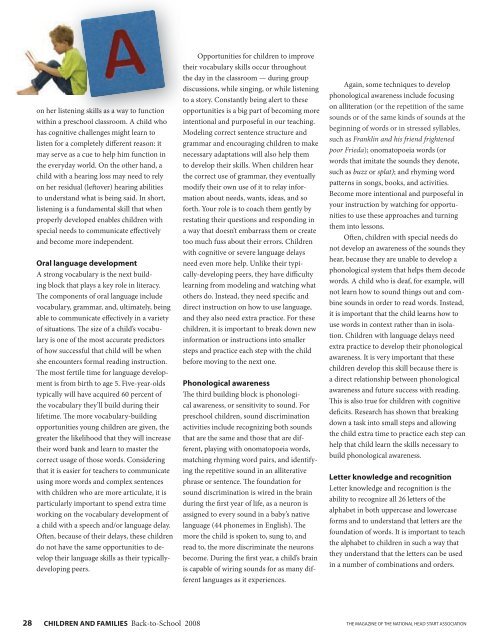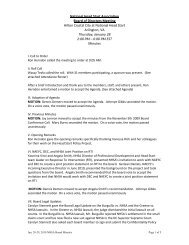New! - National Head Start Association
New! - National Head Start Association
New! - National Head Start Association
You also want an ePaper? Increase the reach of your titles
YUMPU automatically turns print PDFs into web optimized ePapers that Google loves.
on her listening skills as a way to function<br />
within a preschool classroom. A child who<br />
has cognitive challenges might learn to<br />
listen for a completely di erent reason: it<br />
may serve as a cue to help him function in<br />
the everyday world. On the other hand, a<br />
child with a hearing loss may need to rely<br />
on her residual (le over) hearing abilities<br />
to understand what is being said. In short,<br />
listening is a fundamental skill that when<br />
properly developed enables children with<br />
special needs to communicate e ectively<br />
and become more independent.<br />
Oral language development<br />
A strong vocabulary is the next building<br />
block that plays a key role in literacy.<br />
e components of oral language include<br />
vocabulary, grammar, and, ultimately, being<br />
able to communicate e ectively in a variety<br />
of situations. e size of a child’s vocabulary<br />
is one of the most accurate predictors<br />
of how successful that child will be when<br />
she encounters formal reading instruction.<br />
e most fertile time for language development<br />
is from birth to age 5. Five-year-olds<br />
typically will have acquired 60 percent of<br />
the vocabulary they’ll build during their<br />
lifetime. e more vocabulary-building<br />
opportunities young children are given, the<br />
greater the likelihood that they will increase<br />
their word bank and learn to master the<br />
correct usage of those words. Considering<br />
that it is easier for teachers to communicate<br />
using more words and complex sentences<br />
with children who are more articulate, it is<br />
particularly important to spend extra time<br />
working on the vocabulary development of<br />
a child with a speech and/or language delay.<br />
O en, because of their delays, these children<br />
do not have the same opportunities to develop<br />
their language skills as their typicallydeveloping<br />
peers.<br />
Opportunities for children to improve<br />
their vocabulary skills occur throughout<br />
the day in the classroom — during group<br />
discussions, while singing, or while listening<br />
to a story. Constantly being alert to these<br />
opportunities is a big part of becoming more<br />
intentional and purposeful in our teaching.<br />
Modeling correct sentence structure and<br />
grammar and encouraging children to make<br />
necessary adaptations will also help them<br />
to develop their skills. When children hear<br />
the correct use of grammar, they eventually<br />
modify their own use of it to relay information<br />
about needs, wants, ideas, and so<br />
forth. Your role is to coach them gently by<br />
restating their questions and responding in<br />
a way that doesn’t embarrass them or create<br />
too much fuss about their errors. Children<br />
with cognitive or severe language delays<br />
need even more help. Unlike their typically-developing<br />
peers, they have di culty<br />
learning from modeling and watching what<br />
others do. Instead, they need speci c and<br />
direct instruction on how to use language,<br />
and they also need extra practice. For these<br />
children, it is important to break down new<br />
information or instructions into smaller<br />
steps and practice each step with the child<br />
before moving to the next one.<br />
Phonological awareness<br />
e third building block is phonological<br />
awareness, or sensitivity to sound. For<br />
preschool children, sound discrimination<br />
activities include recognizing both sounds<br />
that are the same and those that are different,<br />
playing with onomatopoeia words,<br />
matching rhyming word pairs, and identifying<br />
the repetitive sound in an alliterative<br />
phrase or sentence. e foundation for<br />
sound discrimination is wired in the brain<br />
during the rst year of life, as a neuron is<br />
assigned to every sound in a baby’s native<br />
language (44 phonemes in English). e<br />
more the child is spoken to, sung to, and<br />
read to, the more discriminate the neurons<br />
become. During the rst year, a child’s brain<br />
is capable of wiring sounds for as many different<br />
languages as it experiences.<br />
Again, some techniques to develop<br />
phonological awareness include focusing<br />
on alliteration (or the repetition of the same<br />
sounds or of the same kinds of sounds at the<br />
beginning of words or in stressed syllables,<br />
such as Franklin and his friend frightened<br />
poor Frieda); onomatopoeia words (or<br />
words that imitate the sounds they denote,<br />
such as buzz or splat); and rhyming word<br />
patterns in songs, books, and activities.<br />
Become more intentional and purposeful in<br />
your instruction by watching for opportunities<br />
to use these approaches and turning<br />
them into lessons.<br />
O en, children with special needs do<br />
not develop an awareness of the sounds they<br />
hear, because they are unable to develop a<br />
phonological system that helps them decode<br />
words. A child who is deaf, for example, will<br />
not learn how to sound things out and combine<br />
sounds in order to read words. Instead,<br />
it is important that the child learns how to<br />
use words in context rather than in isolation.<br />
Children with language delays need<br />
extra practice to develop their phonological<br />
awareness. It is very important that these<br />
children develop this skill because there is<br />
a direct relationship between phonological<br />
awareness and future success with reading.<br />
is is also true for children with cognitive<br />
de cits. Research has shown that breaking<br />
down a task into small steps and allowing<br />
the child extra time to practice each step can<br />
help that child learn the skills necessary to<br />
build phonological awareness.<br />
Letter knowledge and recognition<br />
Letter knowledge and recognition is the<br />
ability to recognize all 26 letters of the<br />
alphabet in both uppercase and lowercase<br />
forms and to understand that letters are the<br />
foundation of words. It is important to teach<br />
the alphabet to children in such a way that<br />
they understand that the letters can be used<br />
in a number of combinations and orders.<br />
28 CHILDREN AND FAMILIES Back-to-School 2008<br />
THE MAGAZINE OF THE NATIONAL HEAD START ASSOCIATION




